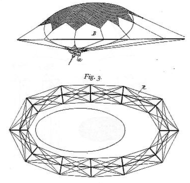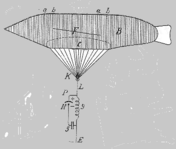|
Atmospheric
Electricity Research
 In
the nineteenth and early twentieth centuries, a large
number of researchers investigated ways to extract electrical
power from the Earth's ambient electric field. In
the nineteenth and early twentieth centuries, a large
number of researchers investigated ways to extract electrical
power from the Earth's ambient electric field.
The
leader in this field was Dr Hermann Plauson who in the
1920s succeeded in generating significant quantities
of electrical power comparable with modern solar photovoltaic
systems of a similar scale.
Background
It
is well known that large quantities of electrical energy
are present in the atmosphere and in lightning. Lightning
was one of the first forms of electricity harnessed
in the modern age by Benjamin Franklin in his famous
kite experiment. Franklin developed a number of electrostatic
motors as well as the lightning conductor for protection
of buildings.
A
lightning discharge contains in the order of 1010
Joules of energy. Several ideas and concepts have been
proposed for collection of lightning as a source of
power. It has been estimated that the total electrical
power of lightning across the Earth is of the order
of 1012 watts.
Lightning
is but a small part of the total electrical activity
of the atmosphere. When a local build up of charge above
the Earth exceeds the local breakdown potential of the
atmosphere a lightning discharge occurs. However, there
is a continual invisible flow of charge from Ionosphere
to Earth occurring day and night over the entire surface
of the globe, which exceeds the global lightning power
output by many times. It is this flow that can be tapped
and directed to provide useable electrical power.
Technical
Approach
The
essence of capturing Atmospheric Electricity is to utilise
the natural electrostatic potential gradient of the
Earth to electrically charge a bank of capacitors or
operate an electrostatic motor/ parametric conversion
machine.
Electricity
is then withdrawn from the capacitors (or condensers
to use the older term) by the load as required.
Alternatively, the parametric conversion device converts
the static atmospheric electricity into conventional
Alternating Current.
The
electrostatic potential gradient between the Earth and
the Ionosphere is about 100Vm-1 near the
surface in summer, rising to 300Vm-1 in winter.
It is well known that electrostatic motors can be driven
by the atmospheric electric field indefinitely from
an appropriate antenna and earth connection.
To
convert this "static" potential field into useable electricity,
an antenna or collector is raised to a suitable altitude.
The static charge collected is then used to charge a
condenser bank or drive an electrostatic parametric
generator that converts the static charge into alternating
current.
Optimum
antenna or collector design is essential. The
antenna can be considered to operate on the same principle
as the Van de Graaf generator. Instead of the
charge being transported continuously from a generator
by a belt to the terminal, charge is transported from
the earth to the terminal by a physical connection.
The terminal then charges up in the same way as a VDG
generator.
Historical
Research
The
leader in this field before the Second World War appears
to have been Dr Hermann Plauson. Dr Plauson was an Estonian
citizen who lived in Hamburg and Switzerland. He carried
out experiments in Finland with aerostats manufactured
from magnesium-aluminium alloy, covered with electrolytically
deposited needles. The needles were further doped with
a radium compound to increase local ionisation of the
air. (This was the era in which the hands of watches
were hand painted with radium to make them luminous
in the dark). Zinc amalgam patches were also painted
onto the aerostats. Plauson obtained a power output
of between 0.72kW and 3.4kW from one and two aerostats
300m above ground level. Dr Plauson filed patents in
the USA, Great Britain and Germany in the 1920s. His
book "Gewinnung und Verwertung der Atmosphärischen
Elektrizität" is the most detailed known account
of the technology.
Other
atmospheric electricity researchers contemporary to
Dr Plauson included Walter Pennock and MW Dewey in the
USA, Andor Palencsar in Hungary and Dr Heinrich Rudolph
in Germany. Hippolyte Charles Vion in Paris predated
them all, putting forward proposals in the 1850s and
1860s.
 Heinrich
Rudolph made an interesting contribution to the design
of the aerostat collectors. In 1898 he designed
an elliptical aerostat made up of faceted surfaces to
minimise the effect of wind. The design bears
a strong resemblance to Northrop's 2003 UCARS unamnned
helicopter UAV project. The design uses the Coanda
Effect to help keep the aerostat on station and
minimise wind effects. Heinrich
Rudolph made an interesting contribution to the design
of the aerostat collectors. In 1898 he designed
an elliptical aerostat made up of faceted surfaces to
minimise the effect of wind. The design bears
a strong resemblance to Northrop's 2003 UCARS unamnned
helicopter UAV project. The design uses the Coanda
Effect to help keep the aerostat on station and
minimise wind effects.
 One
of Hermann Plauson's schematics is also shown here. One
of Hermann Plauson's schematics is also shown here.
In
recent times, the only person who seems to have been
active in this field is Dr Oleg Jefimenko. Dr Jefimenko
carried out experiments on driving electrostatic
motors from the Earth's electric field in the 1970s
and has recently called for research into the neglected
field of electrostatic motors to be renewed.
MIR's
Research Programme
Since
1997 we have been carrying out theoretical research
into conversion of atmospheric electricity into useable
electrical power.
From
a low level (5m high) simple zinc antenna we are able
to obtain sufficient charge to light a number of white
power LEDs. Further experimental investigations with
metallic aerostat collectors and cavity resonant slow
wave antennae concepts are ongoing.
A
number of programmes are underway in developing countries
to provide remote communities with LED lighting instead
of conventional incandescent lighting. LEDs are a very
efficient way to provide lighting for minimal electrical
power requirements. Atmospheric electricity would
be ideally suited to powering domestic LED lighting
or low energy neon lighting.
There
is every reason to believe from our experimental tests
and earlier research by Plauson, Jefimenko and others
that Atmospheric Electricity will be able to provide
practically useful levels of electrical power particularly
suited for off-grid applications in the developing world.
Advantages
of Atmospheric Electricity
- Simple
and robust technology
- Low
Cost technology - much cheaper than photovoltaics
or wind turbines
- Available
day and night in all weather conditions - in fact,
more power is produced at night than during the day
- Available
at any point on the Earth's surface
Theoretical Basis
The ultimate source of obtaining
useable electrical power from the Atmosphere is the
Sun.
The Sun emits continuously a
solar wind of positively charged particles; these are
captured by the Earth's magnetic field and create the
Ionosphere, a highly charged region above the atmosphere.
This positively charged region
in turn induces (by electrostatic induction) a negative
charge on the surface of the Earth. The Earth
becomes in effect an enormous spherical capacitor.
A potential gradient or electric field is thus established
between the two "plates" of this capacitor, the Ionosphere
(or Electrosphere) and the surface. While the
upper strata of the atmosphere conduct electricity reasonably
well, the lower levels act as an insulator or dielectric.
Near the surface of the
Earth, this potential gradient is in the order of 100
Vm-1 in summer, rising to 300 Vm-1
in winter.
In fine weather, currents in
the order of 1000 amperes are flowing continuously from
the atmosphere to ground. During unsettled weather,
the currents can be much higher. As the charge
flows down to Earth, the electrosphere is replenished
by the solar wind.
If we interpose a collector
to intercept and collect some of this flow, nothing
will be lost since after use in a load or circuit, the
charge will be sent on its way to earth. By careful
design, we can use a slow wave structure type of antenna
that acts as if it is much larger than its real physical
dimensions (i.e. it is electrically small) to capture
greater quantities of charge and amplify the input.
We can effectively apply a suction pressure on the electrosphere
in this way to speed up and amplify the local natural
flow of charge, since we are effectively "punching a
hole with a conductor" through the dielectric of the
atmosphere to join the two "plates" of the capacitor
together. As charge is drawn down, the electrosphere
will be simply replenished by the vast quantity of charge
carried by the solar wind.
Ultimately, even if by some
future stupendous need for electrical power we were
to strip part of the ionosphere bare by shorting it
to earth through an enormous conductor, this would simply
create a potential hole that would immediately attract
more solar wind to fill it. Engineering on such
scales is of course well beyond our capabilities, so
there should be no concern about "depleting"
the ionosphere.
References
Battery
Motors
Remediation
|
